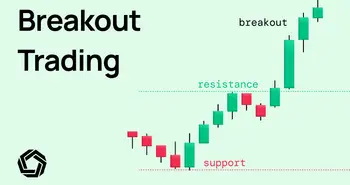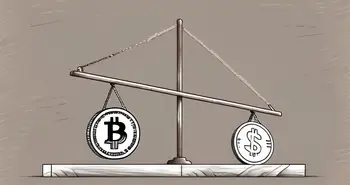Delisting: What Happens When an Asset Is Delisted?

Imagine waking up to find that one of your favorite assets is no longer available on your go-to trading platform. This scenario recently played out with the unexpected delisting of popular tokens like XRP from major exchanges during its legal battle, and the sudden removal of well-known stocks like Luckin Coffee after its accounting scandal. These delistings not only shook investors to their core but also led to significant market volatility and panic selling. But what exactly happens when an asset is delisted? More importantly, can these assets ever make a comeback and reclaim their place on the trading stage? In this article, we'll explore the world of delisting, the factors that lead to it, and the steps you can take to protect your investments if and when it happens.
What Does Delisting Mean
Delisting refers to the removal of an asset, such as a stock, cryptocurrency, or other tradable security, from a trading platform or exchange, making it no longer available for trading on that specific platform. This can happen for a variety of reasons, often related to the financial health of the company, regulatory compliance issues, or changes in the asset’s market value. When an asset is delisted, it generally becomes inaccessible to the majority of investors unless it remains available on another market or platform.

In many cases, delisting is involuntary, driven by factors beyond the control of the asset issuer. For example, a stock might be delisted due to failing to meet exchange listing standards, such as minimum share price or market capitalization requirements. On the other hand, delisting can also be a voluntary decision, often made for strategic reasons like going private or merging with another entity. When a publicly traded company chooses to go private, it aims to reduce costs related to regulatory compliance and gain the flexibility to focus on long-term goals without the constant pressure of quarterly earnings reports.
In addition to these factors, market sentiment can also play a crucial role in the delisting process. If investors lose confidence in a company's ability to recover or grow, the stock may experience a significant drop in value, leading to a breach of the exchange's listing requirements. Moreover, the impact of external economic conditions, such as recessions or industry-specific downturns, can exacerbate the challenges faced by companies, pushing them closer to delisting.
The Delisting Process
Announcement of Delisting
When an asset is on the brink of delisting, the first step is typically a public announcement. This news can catch investors off guard, leading to a range of reactions across the market. Companies must inform the relevant exchange and disclose important details to their shareholders, giving them time to assess their positions and respond accordingly.
For instance, if a tech startup announces its delisting due to financial difficulties, both current investors and potential buyers would need to reevaluate their risk exposure. This kind of announcement often triggers a drop in asset prices as confidence erodes, sparking a wave of trading activity as investors rush to sell off their holdings before the situation worsens. In these moments, trading volumes can temporarily spike as panic selling takes hold and market sentiment turns bearish.
Delisting can be a challenging event for any investor, but understanding its implications and knowing your options can help you turn uncertainty into strategic action. Whether you decide to hold onto your investment, sell before the delisting takes effect, or explore new opportunities, staying informed is key to making the best decision for your financial future.
If you want to stay ahead of the market and make data-driven choices, don't miss out on our expert analysis and real-time insights. Visit Morpher to access the latest updates on market trends, potential delistings, and more.

The Role of Regulatory Bodies
Regulatory bodies play a crucial role in the delisting process by enforcing the rules that companies must adhere to in order to remain listed. For example, in the case of stocks, the U.S. Securities and Exchange Commission (SEC) has the authority to delist shares that fail to meet specific requirements, ensuring that only compliant assets continue to trade.
Investors should stay informed about their rights and responsibilities by closely monitoring updates from these regulatory bodies. Being aware of the guidelines and appeals processes they provide can help investors understand their options if an asset they own is at risk of delisting. This awareness is crucial because the interaction between companies and regulators can be complex, with firms sometimes negotiating terms or attempting to resolve issues to avoid delisting. These maneuvers can have significant implications for investor sentiment and market dynamics.
Implications of Delisting for Investors
Impact on Asset Value
Delisting can have a dramatic impact on the value of an asset. Investors often react negatively to the news, leading to a rapid decline in prices due to increased perceived risk and the reduced liquidity of the asset.
For example, a stock that announces its delisting may see its value drop by 30% or more within a single trading session, driven by fear and uncertainty among shareholders. Once the delisting process is complete, the asset's trading volume generally plummets, making it difficult for investors to exit their positions at favorable prices. The psychological toll on investors can also lead to panic selling, amplifying the downward spiral and further eroding asset value.
Long-term repercussions can be even more severe. Delisted companies or assets often struggle to rebuild trust with investors, which can lead to a prolonged period of low demand and declining value. This challenge makes it difficult for the company to attract fresh capital or secure funding for future operations, often marking the beginning of a broader financial decline.
Options for Investors
When faced with the delisting of an asset, investors still have several options to consider:
Hold onto the asset: Some investors may decide to retain their positions, hoping that the company will turn its fortunes around and eventually relist. This approach requires a deep belief in the asset’s potential and a high tolerance for volatility.
Sell before delisting: If the asset is still actively trading, selling before the delisting is finalized might be a wise move. Acting quickly can help investors recoup part of their investment before liquidity drops further.
Explore other investments: Diversifying into more stable assets or sectors can reduce exposure to delisted securities. This proactive step helps to safeguard the portfolio from similar risks in the future.
Seeking advice from financial professionals or participating in investor communities can also be beneficial. Gaining insights from others who have navigated similar situations can offer guidance on how to approach delisting scenarios and make more informed decisions.
Can a Delisted Stock or Asset Make a Comeback?
One of the most frequently asked questions about delisted stocks or assets is whether they can make a comeback. The short answer is yes, but it depends on several factors that must align for the asset to be relisted on its original or a different exchange.
Conditions for a Comeback
For a delisted asset to make a comeback, the issuing company or project typically needs to address the issues that led to the delisting in the first place. This could involve:
Regaining Compliance: If a stock was delisted for failing to meet the exchange's minimum requirements, such as market capitalization or share price, the company must take steps to meet these thresholds again. This could include restructuring the business, reducing debt, or even conducting a reverse stock split to boost the share price.
Resolving Legal or Regulatory Issues: For companies that were delisted due to legal troubles or regulatory non-compliance, the path to relisting involves resolving these matters. Achieving regulatory compliance or settling legal disputes can pave the way for a potential return to public trading.
Improving Financial Health: If financial instability was the primary reason for delisting, the company would need to demonstrate significant improvements in its earnings, revenue, or overall financial position. Investors need to see tangible progress before they regain confidence in the stock's potential.
Success Stories of Relisting
Although relatively rare, there have been instances where delisted stocks made a successful comeback. A well-known example is the relisting of Hertz Global Holdings on the Nasdaq exchange after its bankruptcy proceedings were resolved. The company restructured its finances, repaid debt, and regained investor confidence, leading to its successful return to the stock market.
Similarly, in the cryptocurrency world, tokens that were delisted due to regulatory issues or low liquidity have sometimes managed to relist on new platforms after addressing compliance concerns and gaining broader adoption.
Challenges and Uncertainty
Even with all the right steps taken, relisting is not guaranteed. The process can be long, complicated, and costly. Moreover, once a stock or asset has been delisted, its reputation can suffer, making it harder to attract new investors. The stigma of having been delisted can linger, affecting market perception and investor sentiment even after the asset is relisted.
Expert Tip: For investors, the possibility of a comeback means they have to weigh the risks and rewards carefully. Holding onto a delisted stock in the hope of a turnaround requires a long-term perspective and a high tolerance for risk. Conversely, for some, the smarter move might be to sell the asset at the earliest opportunity and reallocate their capital to more stable investments.
Ultimately, the chances of a delisted stock or asset making a comeback depend on the underlying company's ability to make significant changes and regain market trust. Investors should closely monitor company announcements, financial health, and regulatory developments to make the most informed decision possible.
Preventive Measures and Alternatives to Delisting
Corporate Actions to Avoid Delisting
Companies can adopt various strategies to prevent delisting and remain in good standing on their respective exchanges:
Regular financial audits: Ensuring compliance with required financial ratios and transparency standards can help companies avoid falling into trouble.
Transparent communication: Keeping shareholders well-informed fosters trust and helps maintain confidence, even during challenging times.
Strategic partnerships: Collaborating with other companies can strengthen financial stability and open up new growth opportunities.
Alternatives to Public Trading
For some companies, stepping away from public trading may present a viable alternative:
Going private: Delisting voluntarily to go private allows companies to focus on long-term goals without the constant scrutiny of public markets.
Mergers and acquisitions: Joining forces with another entity can provide the necessary support and resources to improve the company's financial health and overall performance.
Frequently Asked Questions
- What happens to shareholders when a stock is delisted?
When a stock is delisted, it means it's no longer available for trading on the exchange. This often leads to a sharp drop in the stock's value and makes it more challenging for shareholders to buy or sell their shares due to reduced liquidity.
2. Can a delisted company make a comeback?
Yes, a company can make a comeback if it addresses the issues that led to its delisting, such as improving its financial health or resolving regulatory concerns. In some cases, companies manage to relist on the same or a different exchange after making significant progress.
3. What should investors do if their stock gets delisted?
Investors have several options: they can hold onto the stock with the hope of a future turnaround, sell their shares before the delisting takes effect, or diversify their investments into more stable assets to protect their portfolio.
4. How do regulatory bodies influence the delisting process?
Regulatory bodies set the standards and rules that companies must follow to stay listed. If a company fails to meet these requirements, regulators have the authority to initiate the delisting process to maintain market integrity and protect investors.
5. What steps can companies take to prevent delisting?
To avoid the risk of delisting, companies can conduct regular financial audits, maintain transparent communication with shareholders, and form strategic partnerships to boost performance and stability.
In conclusion, understanding the dynamics of delisting enables investors to navigate their investment journeys more effectively. By staying informed and proactive, you can make decisions that help protect and grow your financial wellbeing.
As you consider the implications of delisting and the importance of having a resilient investment strategy, Morpher offers a unique solution that aligns with the needs of modern investors. With its zero-fee structure, infinite liquidity, and the ability to trade across multiple asset classes, Morpher.com empowers you to navigate the complexities of the market with confidence. Whether you're looking to invest fractionally, short sell without interest fees, or leverage your trades up to 10x, Morpher's revolutionary blockchain-based platform is designed to enhance your trading experience. Take control of your investments with the safety and innovation that Morpher provides. Sign Up and Get Your Free Sign Up Bonus today!

Disclaimer: All investments involve risk, and the past performance of a security, industry, sector, market, financial product, trading strategy, or individual’s trading does not guarantee future results or returns. Investors are fully responsible for any investment decisions they make. Such decisions should be based solely on an evaluation of their financial circumstances, investment objectives, risk tolerance, and liquidity needs. This post does not constitute investment advice.

Painless trading for everyone
Hundreds of markets all in one place - Apple, Bitcoin, Gold, Watches, NFTs, Sneakers and so much more.

Painless trading for everyone
Hundreds of markets all in one place - Apple, Bitcoin, Gold, Watches, NFTs, Sneakers and so much more.









